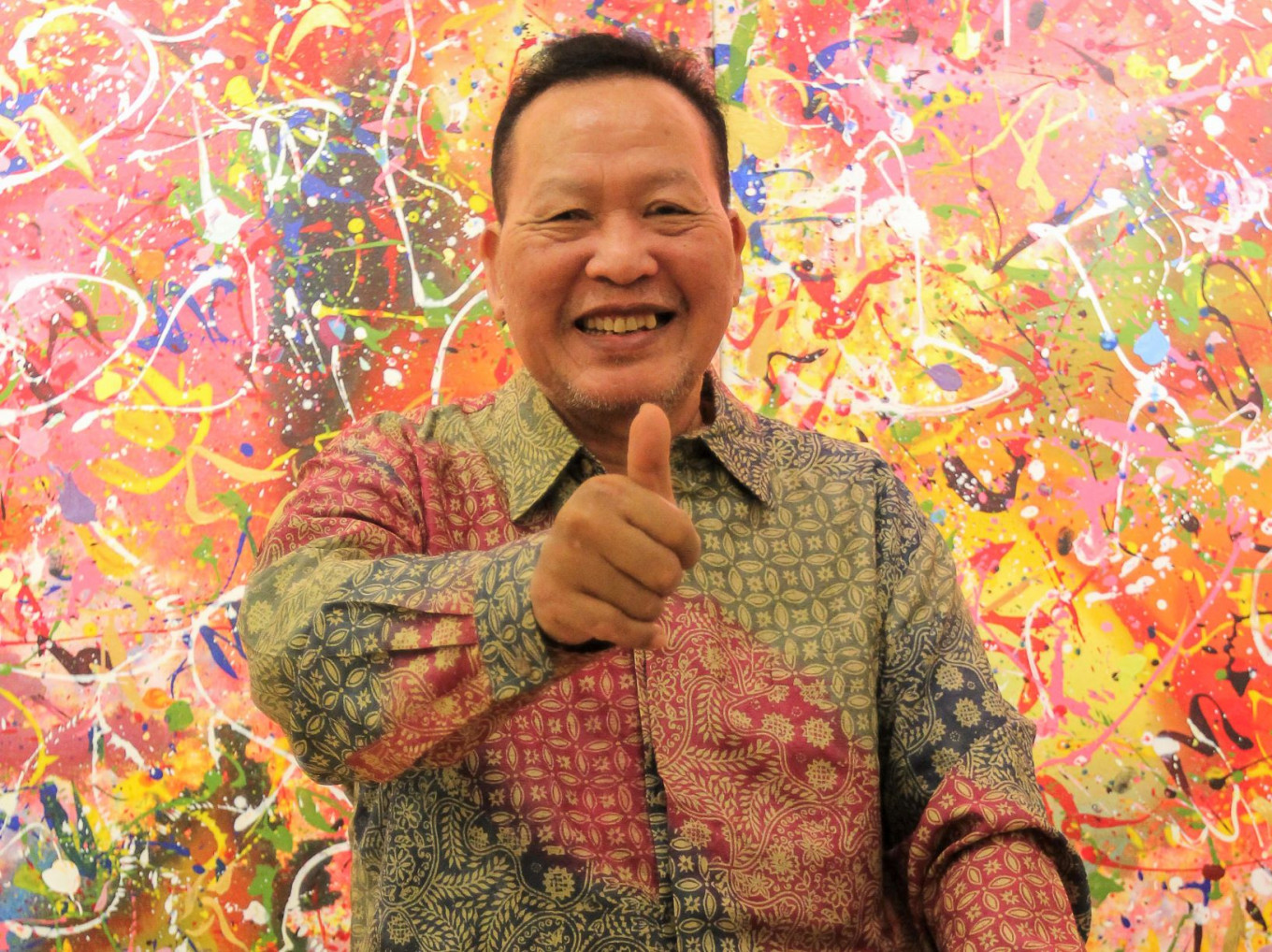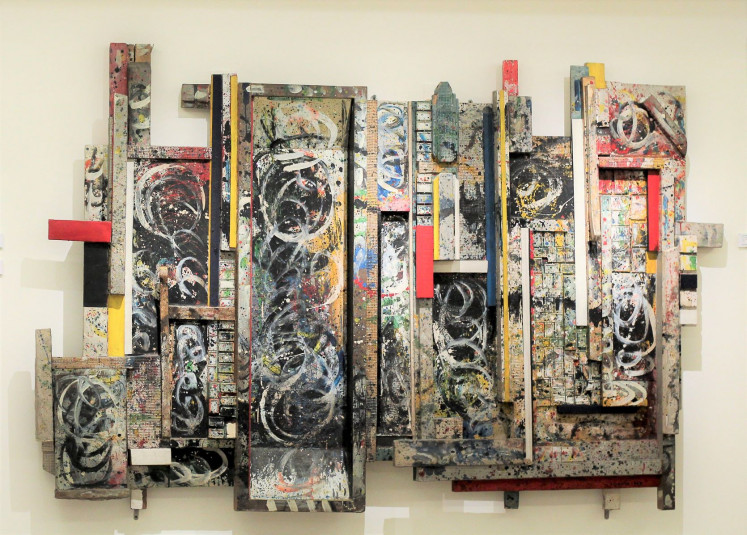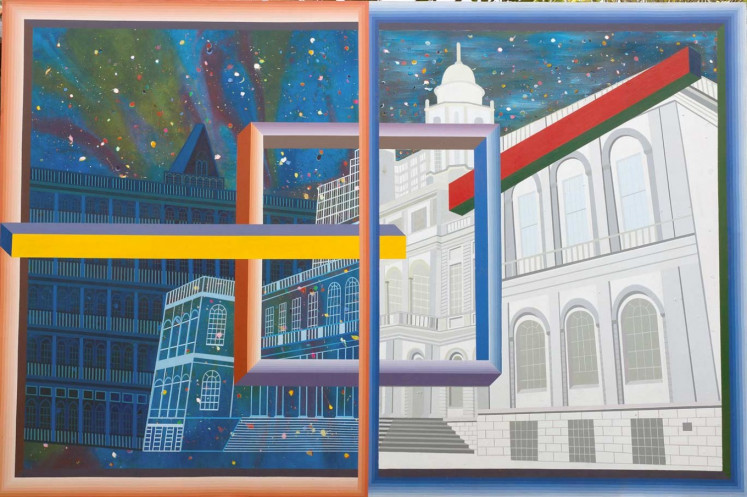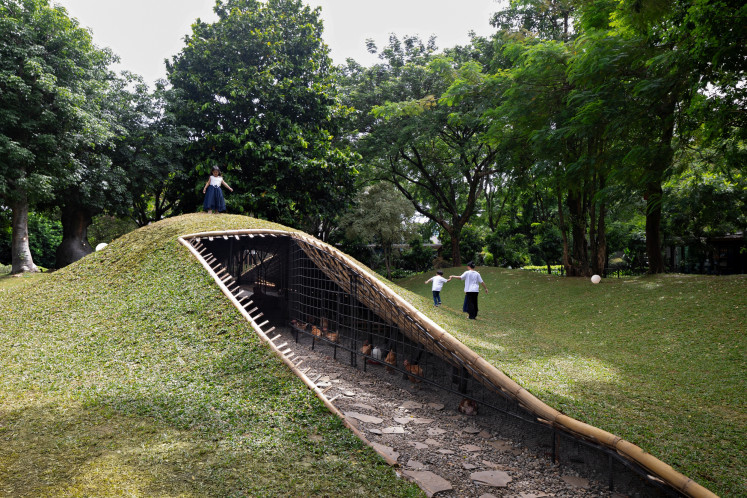Popular Reads
Top Results
Can't find what you're looking for?
View all search resultsPopular Reads
Top Results
Can't find what you're looking for?
View all search resultsIn memoriam: Wianta is gone, his legacy lives on
Indonesia once again bids farewell to a great artist with the passing of multi-talented I Made Wianta.
Change text size
Gift Premium Articles
to Anyone
There was an aura of tranquil acceptance on her face, and a slight hint of sadness.
A few minutes earlier she graciously conversed with scores of important persons, including well-known Balinese architect Popo Danes and noted culturalist I Made Bandem, who offered words of consolation for her loss.
As her guests enjoyed the meal prepared by the villagers, Intan Kirana, 69, sat alone on the plush sofa.
She gazed across the spacious lawn into the main section of the family compound. There, inside a traditional bale pavilion, the body of her deceased husband, I Made Wianta, lay in repose.
A constant flow of mourners ascended into the bale on that Saturday evening to pay their last respects to one of the island's greatest visual artists. In the adjacent building, local women were busy crafting offerings and paraphernalia for the planned cremation.
"He is in a better place now," a smile gradually formed on Intan's face. It was not a wishful statement. Earlier in the morning, the family had visited a medium in a nearby village. It is a custom widely practiced in Bali. Through the medium, the soul of the deceased will speak to his grieving family.
For Balinese Hindus, it is a cathartic experience, providing them with closure and one last opportunity to convey their love to the deceased.
"He said that he is being carried on a palanquin and escorted by beautiful bidadari supernatural beings," Intan said.
When a family member jokingly asked what merit Wianta had accumulated during his life to deserve such a royal after-life treatment, the soul instantly replied: "Because I was a good man, and a handsome one too".
The smile on Intan's face turned into a grin and later a chuckle once she finished narrating that episode.
"It was so him, his high self-esteem, the smugness with which he answered all our questions. it convinced us that he was truly with us this morning," she said.
That self-confidence, Bali's senior dramatist Abubakar suggested, had played an important role in catapulting Wianta into becoming one of the country's most successful visual artists.
"Unlike a majority of painters, who usually are timid and reluctant to market their works personally, Wianta was a passionate promoter of his works. When he later became a successful artist, he used his prowess in marketing and promotion to help Bali's young painters," he said.
Abubakar befriended Wianta and Intan in the mid-1970s, when the couple was still living in destitution in a Denpasar neighborhood mostly populated by kusir dokar (coachmen).
"Another unique quality of Wianta that I admired was his insatiable appetite for exploration. Canvas was not sufficient for him to express himself, he needed paper [to write poetry], he needed the stage [to perform his theatricals], he established friendships with people from every spectrum of society."
Wianta began his cultural exploration in Apuan, an agricultural village near the island's hilly tourism escape of Bedugul. He was born in 1949 into a family that for generations had produced numerous skillful musicians. Naturally, Wianta grew up mastering Balinese traditional musical instruments. In addition, he also mastered Balinese traditional dance.
In the early 1970s, when he was studying at the Indonesian College of Fine Arts (ASRI) in Yogyakarta, Wianta fell in love with Intan Kirana, the soft-spoken granddaughter of Indonesia's father of education Ki Hajar Dewantara. Intan was a dancer in a troupe led by Balinese master I Nyoman Wenten.
"He was one of the troupe's musicians and dancers. When I performed as Trijata, the confidant of Sita in the epic Ramayana, he played one of the monkeys. He purposefully teased me and touched my ankle several times during the performance. When later on I confronted him about that, he mischievously said that a monkey is allowed to humor the princess," Intan recalled.
“City of Destruction” (1997) by I Made Wianta (JP/Bangkit Jaya Putra)Becoming a great painter and visiting cultural centers in Europe were Wianta's two major dreams at that time. But life was difficult for the newly married couple and Wianta nearly resigned himself to the mundane life of a hired typist and later on an art shop attendant.
In 1976 Wianta was recruited to teach batik painting for a cultural program in the Indonesian Embassy at Brussels. It was the decisive moment that unleashed his full potential. He visited museums across Europe and mingled with the continent's creative minds.
"He saw Dali's surrealist works and made his mind up to create the Balinese version of surrealism," Intan said.
Those works, inspired by Balinese belief in and depiction of the unseen realms, as well as supernatural creatures, brought him critical and commercial success. Known as the Karangasem Period after the town in East Bali, the artistic period and style lasted until the mid-1980, after which Wianta began his experimentation with geometric shapes and dots.
In the following years, his fame grew immensely. So did his creative exploration. He penned poetry with Korek Api Membakar Lemari Es (The Match that Torches the Fridge, 1995) being the most talked about. He created stunning installation works and performing arts, including Art and Peace in 1999.
It was the first mass, contemporary performing art show the island had ever seen, involving some 2,000 performers and a 2,000-meter-long cloth painted with quotations from peace activists from across the globe.
Art and Peace was Wianta's response to the political and social turmoil brought about by the fall of the New Order regime, as well as the global economic crisis.
"He was one of the first Balinese artists to embrace globalism – the interconnectedness of the modern world – and its principal issues of human rights, democracy, social justice and environmental conservation.
In this context, he tackled subject matters that were rarely pursued by the other Balinese artists of that period, such as the atrocity of war and the pervasiveness of violence. This is one reason why he was able to gain international recognition," culturalist I Made Bandem said.
“Town Hall NYC” (2014) by I Made Wianta (Courtesy of I Made Wianta/-)The 1990s and 2020s were Wianta's peak period. He exhibited his works in cities in Europe, the United States and Asia, including at the prestigious 2003 Venice Biennale. He was also honored with scores of accolades, including the Dharma Kusuma from the government of Bali.
A traffic accident in Oct. 2015 put an end to his ascent. Wianta was severely injured and never fully recovered.
Intan and his two daughters, Buratwangi and Sanjiwani, kept him company throughout years of slow and fluctuating recovery, during which Wianta divided his time between his house in Denpasar and Apuan.
On the afternoon of Nov. 13, a Friday, his condition abruptly deteriorated. Intan rushed him to a nearby hospital, where the attending physician pronounced him dead at 2.50 p.m. local time. He was 70 years old.
"He was a warm father, he always took us to every cultural activity he was involved in, but he never forced us to be an artist or to be anything else for that matter," Sanjiwani said.
As the fire consumed his body in a simple ritual on Monday in Singaraja, the island once again bid farewell to a great artist. His physical body has gone, but his legacy – some 25,000 artworks he had meticulously archived as well as his stance toward social and political issues – will forever be an inspiration for legions of Balinese artists to come. Vale Maestro! (ste)













